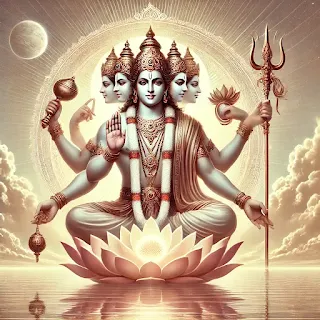Navagraha Stotra - Vedic Mantra
Author: Shweta Goyal
 |
| "Navagraha Stotra - A celestial image of the Navagrahas, embodying protection, prosperity, and spiritual growth through the Navagraha Stotra." |
Introduction
The Navagraha Stotra is a revered hymn dedicated to the nine celestial bodies (Navagrahas) in Hindu astrology: Surya (Sun), Chandra (Moon), Mangal (Mars), Budh (Mercury), Guru (Jupiter), Shukra (Venus), Shani (Saturn), Rahu, and Ketu. These celestial bodies are believed to have a significant influence on human lives and destinies. The Navagraha Stotra is chanted to appease these planets, seeking their blessings for protection, prosperity, and spiritual growth. Each verse of the Navagraha Stotra is dedicated to one of the Navagrahas, praising their qualities and seeking their favor.
Mantra Text
Here is an excerpt from the Navagraha Stotra:
जपाकुसुमसङ्काशं काश्यपेयं महाद्युतिम्।
तमोऽरिं सर्वपापघ्नं प्रणतोऽस्मि दिवाकरम्॥
Japākuśumasaṅkāśaṃ Kāśyapeyaṃ Mahādyutim
Tamo'riṃ Sarvapāpaghnaṃ Praṇato'smi Divākaram
Meaning and Significance
The Navagraha Stotra is a hymn that praises the various attributes and deeds of the Navagrahas. The key themes include:
- **Surya**: The hymn describes Surya as the embodiment of light and energy, who dispels darkness and negativity.
- **Chandra**: The hymn praises Chandra for bringing calmness, peace, and emotional stability.
- **Mangal**: Mangal is honored for providing strength, courage, and determination.
- **Budh**: The hymn highlights Budh as the deity of intellect, communication, and wisdom.
- **Guru**: Guru is revered as the guide and protector, who grants knowledge and prosperity.
- **Shukra**: The hymn lauds Shukra for bestowing love, beauty, and artistic talents.
- **Shani**: Shani is acknowledged as the one who teaches discipline, responsibility, and patience.
- **Rahu and Ketu**: These shadow planets are praised for their role in challenging the individual, leading to spiritual growth and transformation.
Chanting this mantra is believed to invoke divine protection, prosperity, and spiritual awakening.
Benefits of Chanting
Chanting the Navagraha Stotra offers numerous benefits, particularly for those seeking protection, prosperity, and spiritual growth:
- **Planetary Protection**: The hymn is believed to neutralize the malefic effects of planets in one’s horoscope, ensuring protection and well-being.
- **Prosperity and Success**: Regular recitation enhances the positive influence of benefic planets, leading to prosperity and success.
- **Mental Clarity and Focus**: The rhythmic chanting enhances concentration, mental clarity, and focus.
- **Spiritual Growth**: The hymn helps in aligning the individual with cosmic energies, promoting spiritual growth and inner peace.
- **Health and Well-being**: Chanting the Navagraha Stotra is also believed to promote good health and well-being, balancing the energies of the body and mind.
How to Chant the Stotram
To fully benefit from chanting the Navagraha Stotra, follow these guidelines:
- **Best Time to Chant**: Early morning or during the evening, particularly on specific days dedicated to each planet, is considered ideal for chanting the stotra.
- **Number of Repetitions**: Chanting the stotra once daily is common, but it can be recited multiple times for enhanced blessings.
- **Rituals**: Light a lamp and incense in front of an image or idol representing the Navagrahas. Offer flowers, fruits, and prasad while chanting with devotion.
- **Posture**: Sit in a comfortable position with a straight spine, focusing on the image or symbol of the Navagrahas, and chant with full concentration and sincerity.
Mythological Background
The Navagraha Stotra is traditionally chanted during Navagraha Puja, especially when there is a need to appease the planets due to their adverse effects in one’s horoscope. According to Hindu tradition, the nine planets govern various aspects of life, and their positions influence one’s destiny. The Navagraha Stotra is a means to seek their favor and blessings, ensuring a life of peace, prosperity, and spiritual growth.
Conclusion
The Navagraha Stotra is a powerful devotional hymn that offers protection, prosperity, and spiritual growth. By incorporating this stotra into your daily practice, especially during Navagraha Puja, you can align yourself with the divine energy of the planets, ensuring a life of success, well-being, and inner harmony. Chant the Navagraha Stotra with faith and devotion, and experience the transformative power of the Navagrahas’ blessings.
Navagraha Stotra - Author: Shweta Goyal
Meta Information
Meta Title: Navagraha Stotra - Powerful Vedic Hymn for Protection and Prosperity
Meta Description: Discover the meaning, significance, and benefits of chanting the Navagraha Stotra, a powerful Vedic hymn for invoking the blessings of the nine planets for protection, prosperity, and spiritual growth.
Keywords: Navagraha Stotra, Vedic Mantra, Navagraha mantra, planetary protection, prosperity mantra, Hindu hymns, Navagraha worship
Labels & Categories
Navagraha Stotra, Vedic Mantra, Protection & Prosperity, Spiritual Growth, Hindu Hymns, Navagraha Worship, Overcoming Challenges





















